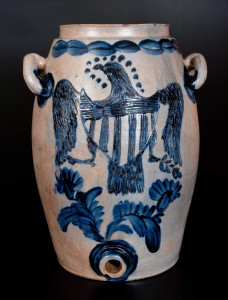SPARKS, MD. — A stoneware water cooler with profuse incised federal eagle motif and attributed to Baltimore, Md., potter Henry Remmey, 1812-29, took $483,000, including buyer’s premium at Crocker Farm’s million-dollar October 17 auction of stoneware and redware pottery. That was more than triple its high estimate of $125,000, and bidders and onlookers did not have to wait long in suspense for the sale’s top lot to materialize, as Crocker Farm traditionally presents its expected heavy hitter as the first lot across the block.
The fresh-to-the-market example was purchased for about $500 by the consignor’s father at a Pennsylvania estate auction in 1974 and it was anticipated to soar. Noted collector Jerry Lauren was the winning bidder, according to Crocker Farm principal Tony Zipp, who opened the lot to a Baltimore collector at $100,000. It then was taken to $180,000 by a Florida collector, then back to Lauren at $190,000. At the $200,000 level, Pennsylvania dealer Kelly Kinzle entered the fray and hung on to become the underbidder at $400,000.
Considered probably unique, the 7-gallon cooler fairly bristles with incised and cobalt-highlighted Federal eagle decoration, the execution of which is attributed to Henry Remmey Sr or Jr, Baltimore, Md, circa 1812-1829. The cooler is large and ovoid with a stepped bunghole and open handles featuring added supports because of its size.
“With its striking figural design and outstanding cooler form, this recently surfaced work ranks as arguably the finest American stoneware object to come to auction since the iconic William Crolius inkstand set a then-record price for the medium at Sotheby’s in 1991,” said Zipp. There are a number of reasons why. The quality and style of the incising, the color of both the clay and cobalt slip, the cooler’s distinctive floral motifs traced to the shop of William Meyers where Remmey worked as factory superintendent, link this object to the New-York-trained potters Henry Remmey Sr and his son, Henry Harrison Remmey. They arrived in Baltimore from Manhattan in 1812, father and son virtually changing the quality and reputation of the city’s stoneware craft overnight. Utilizing potting, decorating and firing skills acquired in Manhattan, the leading style center of American stoneware production, the Remmeys began producing artistic wares unlike anything the Mid-Atlantic had seen before.
A complete report on this sale will appear in an upcoming edition.


